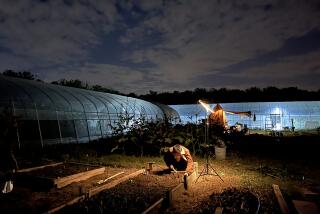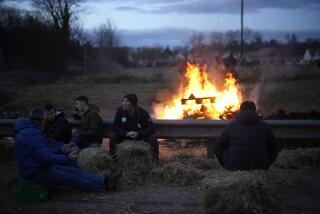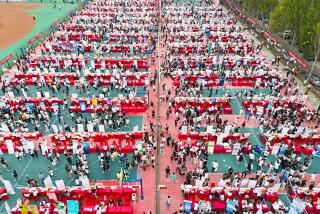Rural Industry Grows : China: How to Keep ‘Em on the Farm
LONGZHAO, China — Four years ago, Liao Zhureng spent her days cultivating rice, wading through the paddies near her thatch-roofed cottage in this small farming village in Sichuan province.
Now, Liao, 30, works in a small garment factory in the village, stamping red labels on khaki shirts. On the whole, she says, she likes the new job, which has enabled her family to rebuild the cottage and to buy a television set. But she admits that she still finds the work a little tense.
“You can’t just go out to the well whenever you want,” she said. “But I am getting used to it.”
The Chinese have an expression for the switch Liao has made. They call it li tu bu li xiang-- “leaving the land but not the village.” People like Liao are changing from farming to industry, without leaving home. At the moment, the phenomenon is one of the most important and politically controversial changes taking place in Chinese society.
Rural Industry Encouraged
Over the next couple of decades as many as 200 million people in China will switch from farming to rural industry the same way Liao did. The Chinese regime has been encouraging the development of small towns and the location of new industry in rural areas as a way of limiting the size of its cities.
But now, some powerful critics in China are voicing the fear that the push toward rural industry is too strong. Last month, Chen Yun, one of the five members of the Standing Committee of the Communist Party’s Politburo, complained that “some peasants are no longer interested in growing grain.”
Chen cited an unpublished Chinese government report that found that peasants can earn more money working in rural industries than by growing grain or other crops.
According to the census of 1982, about 79% of China’s citizens--nearly 800 million people--live in the countryside. At least until very recently, the primary concern of Chinese authorities and scholars has been what to do with this huge population as farming techniques improve and fewer hands are needed in the fields.
‘No America to Go to’
“If our people rush to the cities, we will sink into the ocean,” said China’s pre-eminent sociologist, Fei Xiaotong. “. . . And they have no America, no Australia to go to. If they started coming, you would close the door.”
Last October, the State Council, China’s version of a presidential Cabinet, issued a circular on the settling of peasants in rural market towns. The new policy eased the way for peasants with special skills or management ability to move from farms to villages.
The government has also made it easier for farm villages to set up a town government--a low-level administrative unit providing a degree of local autonomy. And it has gone out of its way to nurture efforts by peasants to set up workshops, factories and other enterprises, which were denounced during the Cultural Revolution as the “tail of capitalism.”
The boom in rural industry--national output was up 53% in the first half of 1985, compared to the same period in 1984--can already be seen in China’s most prosperous agricultural areas, such as Jiangsu province north of Shanghai and here in Sichuan province in southwestern China.
Peasants and Parkas
In farming villages throughout the fertile plain surrounding Chengdu, capital of Sichuan, peasants can be seen putting the finishing touches on Swan-brand parkas for the export market, stitching up fur coats, making furniture and producing wine.
Officials in the village of Fenghuang in Qionglai township, about 50 miles west of Chengdu, told a visitor that five years ago, 90% of the village’s 201 households were employed in agriculture. Today, they said, the figure is down to 20%, and the other 80% are in industry. They said the tiny village has been making wine, bricks, cooking oil and fodder.
Not all its ventures have been successful. When town officials mentioned a village knitting factory and two reporters asked to see it, authorities said the factory was closed for the day; then they said they had no key. Finally, with some reluctance, they took the reporters to a two-story structure filled with broken glass and equipment in disrepair.
An official explained that the knitting factory had been closed for a month because of the township’s inability to obtain supplies. They insisted that it will open again soon.
However, Fenghuang officials said that other ventures, particularly growing yeast and making Flying Phoenix Spirit, the local brand of rice wine, have brought new income to the peasants.
Income Beats Farming
“Now, each house has a television set,” Han Bingqing, the manager of the village’s enterprises, said. “There is one village video recorder, and people play badminton. Most of the young men of the village prefer to stay here.”
In the Longzhao garment factory where Liao works, women doing piecework on sewing machines earn from 80 to 200 yuan a month (about $29 to $71), much more than the average peasant can earn farming.
The township started the factory three years ago, at first having women bring their own sewing machines from home to work together in a large, well-lighted room. The money earned by selling clothes in the markets of Chengdu was used to buy new sewing machines for the factory.
“There was a big problem here before,” Ru Furong, the head of the garment factory, recalled. “There were too many people and not enough land. And you were not allowed to go out and take work elsewhere. Now, instead of young people here wanting to move to Chengdu, people from other areas want to come to work in our town.”
The population figures show clearly why China is trying so hard to promote rural industry.
Pattern of Urbanization
At the moment, China is one of the world’s least urbanized nations. In 1982, only 21% of the Chinese population lived in cities. For the world as a whole, the percentage of urban population is 37%, and even for developing nations the figure is 29%, still much higher than in China.
In all societies, the pattern of development has been for people to migrate out of rural areas and into cities. In China, the general pressures toward urbanization are being compounded by recent changes that have made agriculture much more efficient. Under the so-called responsibility system started by the government of Deng Xiaoping, individual peasants are given financial rewards for increasing production.
“The implementation of the rural responsibility system has created a lot of surplus labor in the rural areas,” commentator An Zhiguo observed recently in the Beijing Review.
By official estimates, because of these increases in productivity, between 200 million and 300 million peasants and their families are expected to give up agricultural work by the year 2000. The urgent question facing planners is where these people will live and work.
If they move to China’s largest cities, many officials believe, it will be a disaster. China now has 46 cities with a population of 1 million or more. Shanghai has 12 million residents, Peking, 9 million, and Tianjin, 8 million.
Cities’ Problems Severe
Even at their present size, the largest cities are facing severe problems of housing, transportation and energy. Many cities in northern China are confronting water shortages as well. An urban planner, Zhao Shiqi, said recently that Shanghai has grown to a point where it has lost its “vitality for future development.”
Amid the rush to put factories in the countryside, there have been a few dissenting voices; some people say it would not be so bad to let peasants move to the cities.
Zuo Mu, an economist for the State Council’s Economic Research Center, told the Shanghai newspaper World Economic Herald last fall that big cities could use large numbers of farmers to help in construction work, food service industries and handicrafts. He said that requiring peasants to stay on their land would be “arbitrary and unreasonable.”
Advantages in Cities
The Tianjin Daily said recently that the movement of rural workers--carpenters, seamstresses and household, help among others--into cities has several advantages, and added, “It provides conveniences for urban residents and new opportunities to earn money for the surplus rural labor force.”
In a recently published book, “Rural Development in China,” Dwight H. Perkins, director of Harvard University’s Institute for International Development, and World Bank economist Shahid Yusuf argue: “The only real solution is to allow farmers, particularly those in the poorest regions, to go to the cities. They may not have to go to Shanghai or Peking, but they must go to cities somewhere.”
But at least for now, the dominant view in China is that the movement of peasants to the cities should be strictly limited.
“Rapid urbanization has caused severe problems in many other countries already,” the World Economic Herald observed recently. “ . . . With its huge population of 1 billion, China not only needs a strict population-control program, but also needs to curb the expansion of its big cities.”
More to Read
Sign up for Essential California
The most important California stories and recommendations in your inbox every morning.
You may occasionally receive promotional content from the Los Angeles Times.










